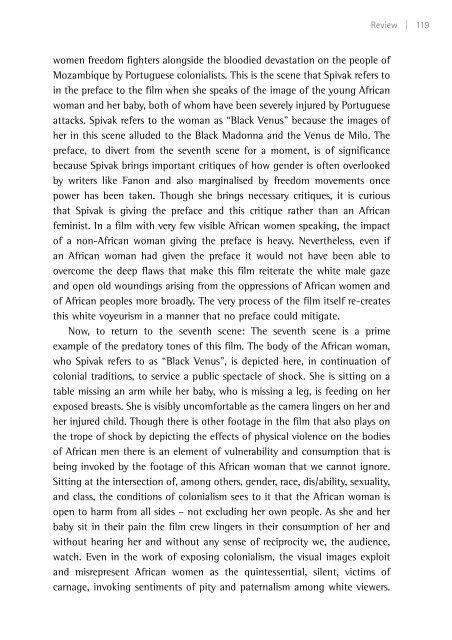Create successful ePaper yourself
Turn your PDF publications into a flip-book with our unique Google optimized e-Paper software.
women freedom fighters alongside the bloodied devastation on the people of<br />
Mozambique by Portuguese colonialists. This is the scene that Spivak refers to<br />
in the preface to the film when she speaks of the image of the young African<br />
woman <strong>and</strong> her baby, both of whom have been severely injured by Portuguese<br />
attacks. Spivak refers to the woman as “Black Venus” because the images of<br />
her in this scene alluded to the Black Madonna <strong>and</strong> the Venus de Milo. The<br />
preface, to divert from the seventh scene for a moment, is of significance<br />
because Spivak brings important critiques of how gender is often overlooked<br />
by writers like Fanon <strong>and</strong> also marginalised by freedom movements once<br />
power has been taken. Though she brings necessary critiques, it is curious<br />
that Spivak is giving the preface <strong>and</strong> this critique rather than an African<br />
feminist. In a film with very few visible African women speaking, the impact<br />
of a non-African woman giving the preface is heavy. Nevertheless, even if<br />
an African woman had given the preface it would not have been able to<br />
overcome the deep flaws that make this film reiterate the white male gaze<br />
<strong>and</strong> open old woundings arising from the oppressions of African women <strong>and</strong><br />
of African peoples more broadly. The very process of the film itself re-creates<br />
this white voyeurism in a manner that no preface could mitigate.<br />
Now, to return to the seventh scene: The seventh scene is a prime<br />
example of the predatory tones of this film. The body of the African woman,<br />
who Spivak refers to as “Black Venus”, is depicted here, in continuation of<br />
colonial traditions, to service a public spectacle of shock. She is sitting on a<br />
table missing an arm while her baby, who is missing a leg, is feeding on her<br />
exposed breasts. She is visibly uncomfortable as the camera lingers on her <strong>and</strong><br />
her injured child. Though there is other footage in the film that also plays on<br />
the trope of shock by depicting the effects of physical violence on the bodies<br />
of African men there is an element of vulnerability <strong>and</strong> consumption that is<br />
being invoked by the footage of this African woman that we cannot ignore.<br />
Sitting at the intersection of, among others, gender, race, dis/ability, sexuality,<br />
<strong>and</strong> class, the conditions of colonialism sees to it that the African woman is<br />
open to harm from all sides – not excluding her own people. As she <strong>and</strong> her<br />
baby sit in their pain the film crew lingers in their consumption of her <strong>and</strong><br />
without hearing her <strong>and</strong> without any sense of reciprocity we, the audience,<br />
watch. Even in the work of exposing colonialism, the visual images exploit<br />
<strong>and</strong> misrepresent African women as the quintessential, silent, victims of<br />
carnage, invoking sentiments of pity <strong>and</strong> paternalism among white viewers.<br />
Review | 119


